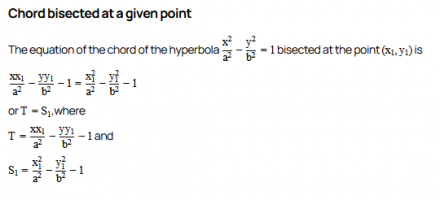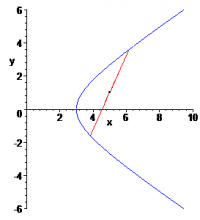DarkLord76865
New member
- Joined
- May 21, 2022
- Messages
- 2
The problem goes like this:
there is a point [math]T (5, 1)[/math] which bisects chord of hyperbola [math]4x^2-9y^2=36[/math]I need to find the equation of line of that chord.
I've found this on the Internet:

It gives correct solution [math]20x-9y-91=0[/math] but I don't understand why. What is T and S1? T looks like an equation for tangent on a hyperbola in given point, and S1 looks like an equation for hyperbola. None of this makes sense to me because given point [math]T (5, 1)[/math] is NOT on given hyperbola.
I've also found this video, but I have trouble understanding anything the guy speaks.
Hope someone can clarify
Thanks
there is a point [math]T (5, 1)[/math] which bisects chord of hyperbola [math]4x^2-9y^2=36[/math]I need to find the equation of line of that chord.
I've found this on the Internet:

It gives correct solution [math]20x-9y-91=0[/math] but I don't understand why. What is T and S1? T looks like an equation for tangent on a hyperbola in given point, and S1 looks like an equation for hyperbola. None of this makes sense to me because given point [math]T (5, 1)[/math] is NOT on given hyperbola.
I've also found this video, but I have trouble understanding anything the guy speaks.
Hope someone can clarify
Thanks

